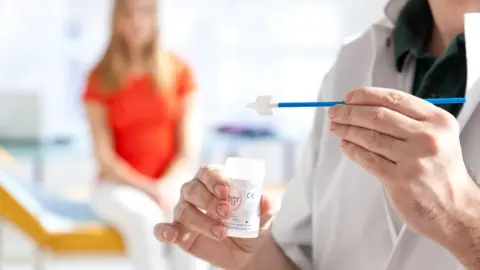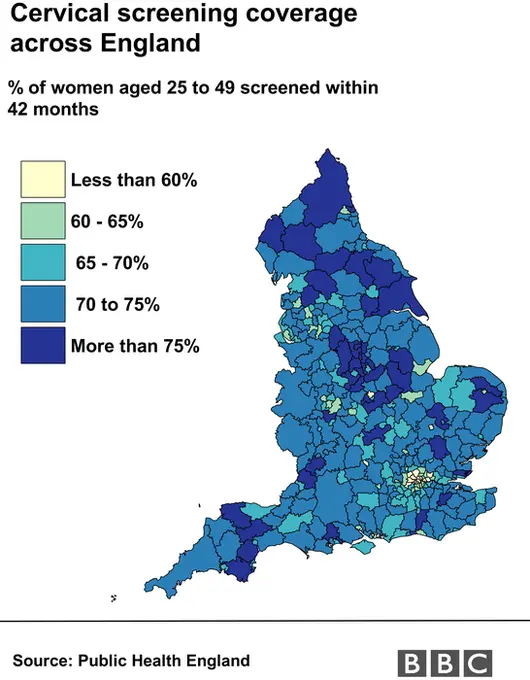Is it time for 'smear test' to be rebranded?
 Science Photo Library
Science Photo LibraryThe government has launched its first cervical screening advertising campaign in England, as the number of women having checks has hit a 20-year low.
The campaign - being run by Public Health England - has avoided the term "smear test" amid concern it may be putting people off.
Officials said the term was outdated and hope the term cervical screening will "normalise" the procedure.
Adverts will run on TV, radio and online for the next eight weeks.
The campaign stresses the screening is basically a health check for the cervix and shows a woman being reminded by family members and friends to go for testing.
Figures last year showed just over 71% of women aged 25 to 64 had been screened at regular enough intervals.
PHE director of screening Anne Mackie said the campaign was about "breaking down barriers".
She said there were a variety of reasons for not attending but there had been a conscious move away from the term "smear test".
"The technical process used today no longer smears the sample of cells from the cervix on to a glass plate," she said.
"We now put cells that we collect into a tube of liquid, so technically 'smear' is incorrect."
 NHS
NHSMs Mackie said the overarching message of the campaign - cervical screening saves lives - was much more "clear and direct" and "hopefully helps to normalise the term".
She added: "The campaign shows how cervical screening is a vital preventative test which can identify potentially harmful cells and treat them before they have a chance to develop into cancer, giving us the opportunity to stop cancer before it starts."
'Don't delay cervical screening'
 other
otherMasters student Isha Webber, 29, from London, attended her first screening appointment when she was 25. It came back all clear.
A few years later, when she was screened again, she was found to have abnormal cells that required treatment to remove.
"I can't reinforce enough how important it is to stay on top of your cervical screening appointments," she said.
"When you get your invitation letter, book right away and don't delay.
"I am so glad that I went when I did and had those abnormal cells removed.
"I hate to think what may have been the case if I delayed.
"I now talk to as many people as possible about my experience, to raise awareness of the importance of screening."
Why are screening rates so low?
The NHS target is for 80% of women aged 25 to 49 to be tested every three years and the same proportion aged 50 to 64 to be screened every five years.
But in some areas uptake has dropped below 50%.


Experts have put it down to:
- embarrassment
- a lack of awareness
- just putting it off
Research by the charity Jo's Cervical Cancer Trust suggested young women were embarrassed to attend because of:
- their body shape
- the appearance of their vulva
- concerns over smell
A third said they would not go if they had not waxed or shaved their bikini area.
And about 15% said they would miss their screening test for a gym class or a waxing appointment.
What else is being done to improve uptake?
Every year about 2,600 women are diagnosed with cervical cancer and nearly 700 die from the disease.
The advertising campaign is just one element of the government's approach to increase uptake.
A review of invitation letters, leaflets and results letters is under way, while pilots to trial text messaging reminders have started.
Some areas have also started to offer weekend and evening screening.
Government advisers are also considering whether to recommend self-testing.
Jo's Cervical Cancer Trust chief executive Robert Music said: "We know attending screening isn't always easy for a wide range of reasons, yet cervical screening can be lifesaving as it can detect changes in the cervix before they become cancerous."
The Scottish government and NHS Scotland ran a cervical screening advert in 2017, telling women to "stop fannying about" and "nip cancer in the bud". While it used the term smear test, the NHS Health Scotland website primarily refers to it as cervical screening.
The Cervical Screening Wales site refers to both cervical screening and smear tests, as does the official site in Northern Ireland.
